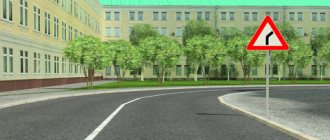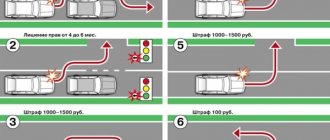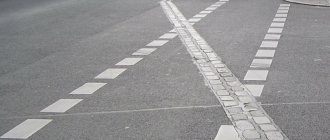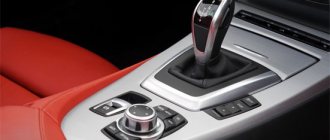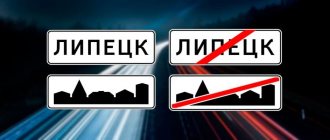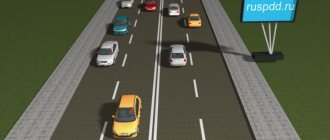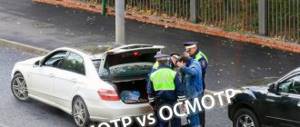What vehicles are considered low-speed?
In legislation, the criterion for a slow-moving vehicle is considered to be only speed. So this includes all equipment that is not capable of accelerating when moving above 30 kilometers. This is documented in the passport and technical factory specifications. This also means that at the plant, initially, when producing equipment that falls under the sign of a low-speed vehicle, the following speed parameters and limiters are laid down.
The traffic rules provide for a special sign for such a vehicle. It looks like a red triangle, framed on all sides by a yellow or red border. The frame has reflective properties. The entire sign is painted with a fluorescent coating.
For vehicles with low speed characteristics, installation of an identification mark is mandatory. It is installed on the back of the vehicle, thus informing the next motorist about its technical parameters and slow driving. Therefore, it is possible to determine whether the vehicle ahead is slow-moving only by looking at the corresponding sticker. The second indicator of low speed will be your exact knowledge that the vehicle actually has such a factory characteristic. Most often this is a technique used in road and construction work, and in agriculture. Please note that a slow-moving car cannot be considered a slow-moving vehicle. These are not identical concepts. For example, a motorist may drive at a low speed due to personal reasons - a breakdown, looking for landmarks in a foreign area, looking for a place to stop. Therefore, the exclusion of the possibility of overtaking as for a slow-moving mode of transport does not apply to it. Let's look at these details below.
Rules for avoiding slow traffic participants
According to established regulations, all aspects of vehicle movement are strictly regulated.
The legality of performing an overtaking maneuver is also described in the law. In emergency areas, vehicle drivers are limited in their freedom of movement like nowhere else. In most cases, a “No Overtaking” warning is installed in such zones. However, what to do in a situation where an object, equipped with a low-speed vehicle marking, is moving along a highway at a speed of 15 km/h. If there is a sign prohibiting overtaking of the car in front, the driver is allowed to bypass:
- mopeds;
- harnessed carts;
- bicycle transport;
- motorcycles not equipped with a cradle;
- low-speed vehicle.
Such a permit is valid only if there is a “No Overtaking” road sign. If the road has a continuous dividing strip, then in the absence of a sign, crossing it is impossible even to overtake a slow-moving vehicle. In a situation where both a sign and continuous markings are installed, it is possible to overtake the above types of transport, but only within the coverage area of the sign prohibiting detour.
According to the provisions of the Code of Administrative Offences, if a slow-moving vehicle interferes with the normal movement of other cars on the road, then the driver is obliged to take all measures to resolve such a situation. This can be either an adjustment of one’s own trajectory of movement to the right, or a complete stop.
It should be noted that in areas containing structures such as bridges, overpasses or tunnels, passing by any vehicle, regardless of its speed, is strictly prohibited. You cannot make overtaking maneuvers either on or under such structures. It should be noted that in areas containing structures such as bridges, overpasses or tunnels, passing by any vehicle, regardless of its speed, is strictly prohibited. You cannot perform overtaking maneuvers either on or under such buildings.
The traffic rules define a list of places where overtaking slow-moving vehicles is prohibited:
- intersections equipped with traffic lights or other means of traffic control;
- railway crossings and overpasses, including sections of the road leading to them (their length is 100 meters before and after crossing the railway tracks);
- uncontrolled intersections if vehicles travel on a secondary road;
- if the maneuver creates an emergency situation on the route;
- the car in front goes around an obstacle or overtakes;
- if there is another car moving between the driver and the slow-moving vehicle that is not overtaking;
- the following car began to overtake;
- the presence of a continuous marking line and the absence of a sign prohibiting overtaking;
- in areas with poor visibility;
- presence of signs indicating dangerous turns;
- at pedestrian crossings;
- at the ends of steep slopes.
If such violations are recorded by traffic police officers or tracking means, the violators will be subject to fines and other penalties.
Effect of the "Slow Moving Vehicle" sign
The identification mark has dimensions determined by GOST, a fixed pattern. The designation is presented on slow-moving vehicles on the left side. This facilitates a quick response to the situation of the cars behind it. The sign is used as an identification element that informs about the high-speed technical features of the vehicle.
Traffic regulations and slow-moving vehicles
Point No. 11 of the Russian traffic rules strictly prohibits overtaking slow-moving vehicles on the following sections of the route:
- Regulated (with traffic lights) intersections.
- Unregulated intersections when driving on a non-main road.
- Railway crossings, as well as areas at a distance of no more than 100 m from them.
- The vehicle in front of you is detouring or overtaking an obstacle.
- Bridges, overpasses, tunnels, overpasses and sections of the highway under them.
- The vehicle following you began to overtake.
- Dangerous turns, ends of climbs, areas with limited visibility.
- Once you have overtaken, you will not be able to get back into the lane without creating a hazard or obstructing the road.
Sign 3.20 “Detour, overtaking prohibited” does not allow you to overtake all vehicles, except for low-speed ones - bicycles, mopeds, horse-drawn vehicles, two-wheeled motorcycles, which not only move less than 30 km/h, but also have an identifying bordered triangle. With a solid line (designation 1.1, 1.11), even a low-speed vehicle cannot be overtaken.
That’s all we wanted to tell you about the GOST requirements for the “Slow-moving vehicle” sign, as well as the rules for driving slow-moving vehicles, overtaking them according to the Russian Federation Traffic Regulations, as well as other legislative acts.
source
When is overtaking a slow-moving vehicle allowed?
We recommend that you find out what overtaking is? A lawyer about the rules for its implementation and the difference from anticipation.
You can overtake low-speed vehicles safely without breaking the rules:
- with intermittent road markings;
- when there is a broken line on a sign prohibiting overtaking.
It should be clarified that in the instructions for the designation 3.20 “Overtaking is prohibited”, as an explanation, vehicles are prescribed that are not subject to the overtaking ban.
Low-speed vehicles are included in this list. Thus, overtaking a slow-moving vehicle at a sign prohibiting maneuver is permitted. How can a motorist following such a vehicle safely overtake a slow-moving vehicle? It is necessary to adhere to and take into account the following points:
- first of all, be sure to evaluate the safety of the maneuver;
- look around and determine whether there are additional signs, dotted markings;
- make sure that visibility allows you to overtake;
- make sure that you are driving in the opposite direction and your speed will allow you to make a safe maneuver;
- when maneuvering, indicate a left turn;
- overtake slow-moving vehicles;
- show the right turn signal, change lanes.
I would like to draw your attention to the fact that the requirements for a driver driving a slow-moving vehicle are established at the legislative level. So he needs:
- When driving, keep to the right to facilitate overtaking. This requirement is met at the moment when the vehicle moving behind it attempts to overtake;
- stop on the side of the road and give way to passing traffic. This action must be performed when there is a traffic jam on the road, and overtaking for other motorists is not safe or is difficult, for example, due to road repair work carried out in the summer, or during the winter - the work of snow removal equipment;
- do not interfere with other drivers in advancing or overtaking. For example, do not make deliberate trips to the middle of the road or increase the speed of the controlled vehicle. This will be perceived as a violation of the requirements for driving a low-speed vehicle. Compliance with the above points is mandatory for drivers of low-speed vehicles. In case of non-compliance, a fine is provided under Article 12.15 of the Code of Administrative Offenses from 1000 to 1500 rubles.
Sign
Many road signs cause difficulties for both beginners and experienced drivers. One of them can safely be called the “Slow-moving vehicle” sign. In this article we will analyze in detail both him and the vehicles that may be marked by him, as well as the rules for overtaking such vehicles.
Description of the sign
The “Slow Moving Vehicle” sign, a photo of which you can see in this article, complies with the conditions of UNECE regulations No. 69-01 (with amendment 01). The kit consists of one panel used as a rear identification badge. It is usually made of aluminum, but can also be presented in the form of a self-adhesive film, as well as a plate with a PVC base.
Appearance - an equilateral triangle of a red or orange hue with a yellow (sometimes red) border, the corners of which are cut off. The base of the sign is necessarily fluorescent, and the border is reflective.
Designation dimensions
The sign “Slow-moving vehicle” has the following dimensions of the sides of a regular (in other words, equilateral) triangle: 350-365 mm.
It is important that the parameters of not only the designation itself, but also its edging, comply with state standards.
So, for the border of the “Slow-moving vehicle” sign, the dimensions according to GOST are the permissible width within the range of 45-48 mm. Let's move on to the installation and fastening rules.
Installation of designation
The “Slow-moving vehicle” sign is placed in such a way that all its characteristics must be preserved with minimal concessions - only covering no more than 10% of its surface with non-removable structural parts of the vehicle is allowed. During operation of a low-speed device, it is necessary to prevent the identification triangle from being affected by manufacturing and design defects.
The fastening, accordingly, must be strong and static - the use of rivets, screws, and special double-sided tape is allowed. It is important to provide easy access to the outer surface of the sign to periodically clean it from dirt.
Accommodation and layout
When placing a sign, be sure to place it strictly with one side of the triangle facing up. In relation to the transverse vertical beam - only at an angle of 90 degrees to the longitudinal axis of the vehicle. Deviation within 5 degrees is allowed.
The designation must be presented only in the singular and located on the side of the vehicle (right or left) that is opposite to the direction of traffic in a given country.
The lower level of the symbol must be no lower than 25 mm above the ground surface, and the upper level must be no more than 150 cm above it.
The sign must be installed at the rear of all mechanical vehicles for which its manufacturer has determined the highest speed, not exceeding 30 km/h.
The “Slow Moving Vehicle” sign is reflected in the following legal documents:
- Technical regulations of the Customs Union 018/2011. Vehicles belonging to categories M, N, O, the highest design speed of which is not more than 40 km/h, are required to be marked with this designation.
- Federal Law of the Russian Federation No. 77. Regulation of fines for drivers of slow-moving vehicles.
- Traffic rules 11.6. The rules require that in conditions where overtaking a device equipped with a “Slow Moving Vehicle” sign is difficult or impossible, the driver of it should stay to the right or even stop if necessary to let the following high-speed vehicle pass.
- Code of Administrative Violations (Article 12.15, Part 1, Clause 1.1). Introduction of a fine for the owner of a low-speed vehicle (travelling less than 30 km/h), who did not provide the driver of a faster vehicle with the opportunity to overtake, in the amount of 1-1.5 thousand rubles.
- Code of Administrative Offenses of the Russian Federation (Article 12.15). In the spring of 2021, another penalty was introduced for drivers of slow-moving vehicles - 500 rubles for driving without an identification marking.
Polysemy of the concept
When passing the theoretical part of the driver's license exam, many people make the mistake of choosing the wrong low-speed vehicle in the test.
Relying on intuition, future drivers include here vehicles that, logically, cannot reach high speeds - a bicycle, a horse-drawn cart, a tractor.
However, in some tests this question is somewhat complicated: the photo for the task shows a racing bicycle, sports competitions involving horse-drawn carriages, etc. So what should you choose?
The issue is resolved very simply. Only those vehicles that have the appropriate sign can be considered slow-moving. Without it, even a tricycle and an antediluvian cart cannot be called a slow-moving vehicle.
Traffic rules and slow-moving vehicles
Point No. 11 of the Russian traffic rules strictly prohibits overtaking slow-moving vehicles on the following sections of the route:
- Regulated (with traffic lights) intersections.
- Unregulated intersections when driving on a non-main road.
- Railway crossings, as well as areas at a distance of no more than 100 m from them.
- The vehicle in front of you is detouring or overtaking an obstacle.
- Bridges, overpasses, tunnels, overpasses and sections of the highway under them.
- The vehicle following you began to overtake.
- Dangerous turns, ends of climbs, areas with limited visibility.
- Once you have overtaken, you will not be able to get back into the lane without creating a hazard or obstructing the road.
Sign 3.20 “Detour, overtaking prohibited” does not allow you to overtake all vehicles, except for low-speed ones - bicycles, mopeds, horse-drawn vehicles, two-wheeled motorcycles, which not only move less than 30 km/h, but also have an identifying bordered triangle. With a solid line (designation 1.1, 1.11), even a low-speed vehicle cannot be overtaken.
That’s all we wanted to tell you about the GOST requirements for the “Slow-moving vehicle” sign, as well as the rules for driving slow-moving vehicles, overtaking them according to the Russian Federation Traffic Regulations, as well as other legislative acts.
Responsibility for violating traffic rules
The likelihood of non-compliance with the rules when overtaking a slow-moving vehicle is high. Here it is important not so much to fear a fine, but to take care of your life, your vehicle and respect other road users on the road. It is not by chance that I am focusing on this. The majority of accidents involve improper overtaking. Therefore, administrative responsibility calls for thinking about this again. Part 4 of Article 12.15 of the Code of Administrative Offenses provides for a fine for crossing a solid line equal to 5,000 rubles. In addition, a violation may result in the confiscation of your driver's license for a period of four to six months. If the offense is repeated, the time period of possible deprivation of rights increases to one year. In the case when a traffic violation is video recorded, only an administrative penalty is applied, i.e. fine. The measure of deprivation of rights is not applied.
Polysemy of the concept
When passing the theoretical part of the driver's license exam, many people make the mistake of choosing the wrong low-speed vehicle in the test. Relying on intuition, future drivers include here vehicles that logically cannot reach high speeds - a bicycle, a horse-drawn cart, a tractor. However, in some tests this question is somewhat complicated: the photo for the task shows a racing bicycle, sports competitions involving horse-drawn carriages, etc. So what should you choose?
The issue is resolved very simply. Only those vehicles that have the appropriate sign can be considered slow-moving. Without it, even a tricycle and an antediluvian cart cannot be called a slow-moving vehicle.
Overtaking through a continuous road
A solid line (1.1), or a solid line and a dotted line located on the left (1.11) prohibits overtaking of any vehicle. You cannot overtake even a slow-moving vehicle. Let's consider a case that is obvious at first glance and contradictory: we see the sign “Overtaking is prohibited”, we remember that overtaking a low-speed vehicle is allowed by the rules. We immediately switch our attention to the solid line, and remember that the overtaking maneuver cannot be performed. A contradiction arose. Is it possible to overtake through a continuous road? Legislation has taken measures to eliminate it. In the Resolution of the Plenum of the Supreme Court in July 2021, this discrepancy was analyzed in detail. As a result, the traffic rules have been supplemented with clause 9.1., which contains an explanation that it is prohibited to enter the oncoming lane, designated solid or solid with an additional intermittent one located on the left. Such a maneuver can result in a fine of 5,000 rubles or deprivation of the right to drive a car for a period of 4 to 6 months.
Additionally, we recommend that you study the issue of completing overtaking through solid markings, since it is quite controversial.
How to overtake
In order to overtake slow-moving vehicles, you need to make sure that this maneuver is allowed in this area. When overtaking slow vehicles, different rules apply, unlike overtaking passenger cars.
If there is a broken marking line on the roadway, there are no intersections and no signs establishing a prohibition on overtaking, then you can maneuver without hesitation. However, if there are restrictions, then it is worth carefully studying the rules regarding slow-moving vehicles.
Overtaking on the side of the road
It is prohibited to drive on the side of the road and, especially, to overtake on the right side of the road. For this there is a significant fine of 1,500 rubles. Such an administrative penalty is regulated by Article 12.15 of the Administrative Code. At the same time, the driver driving the slow-moving vehicle, on the contrary, is recommended to try while driving, with a row of cars lined up behind him, to clear the road as much as possible for overtaking in order to organize the passage of accumulated traffic. Thus, the driver of a slow-moving vehicle, following paragraph 11.6 of the Traffic Rules and moving along the side of the road or stopping on it, does not violate the rules, but fulfills their requirements.
Responsibilities of a slow-moving vehicle driver
If the roadway is narrow, overtaking may be difficult. And if there is large equipment driving ahead, it will be even more difficult to do so. Therefore, the driver of a slow-moving vehicle is obliged to monitor the road situation. If he sees that the car behind is not able to begin the maneuver, he must move as far to the right as possible or even stop to clear the way.
It turns out that motorists find themselves hostage to the situation. The one who drove up from behind is forced to wait until the person sitting behind the wheel of the slow-moving vehicle remembers the Rules of the Road. By the way, if the driver of a slow-moving vehicle does not allow the vehicle to pass, he will face a fine of 1,000 to 1,500 rubles.
Remember that overtaking is always a risk. Regardless of what kind of transport you have in front of you, it is important to make sure that your actions will comply with traffic regulations. Make sure that there is really a slow-moving vehicle ahead, and only then make a decision about maneuvering.
Fine for illegal overtaking and other violations
In 2021, changes were made to the traffic rules. Traffic rules provide for the liability of drivers for illegal overtaking maneuvers, and the liability of drivers of slow-moving vehicles for obstructing the flow of traffic.
Responsibility is provided:
- for the absence of an identification mark on slow-moving vehicles - a fine of 500 rubles or a warning,
- if the driver violated clause 11.6 of the traffic rules and created difficulties for the movement of other vehicles - a fine for a slow-moving vehicle from 1000 to 1500 rubles (Article 12.15 clause 1.1),
- for overtaking on the side of the road - a fine of 1,500 rubles (bicycles and mopeds can use the side of the road),
- for unjustified overtaking of a vehicle that is not slow-moving, in the coverage area of markings (1.1, 1.3, 1.11) or sign 3.20 - a fine of 5,000 rubles or deprivation of a driver’s license for 4 months (Article 12.15 of the Administrative Code),
Drivers of heavy vehicles and heavy special equipment are reluctant to give way to ordinary cars and significantly slow down traffic. Meeting with such a vehicle is annoying, since it is not always possible to overtake without violating the rules.
However, you should be patient, because the risk of losing your driver's license is very high. Amendments to the traffic rules, which came into force in 2021, should affect the behavior of slow-moving vehicles outside populated areas. Those who like to collect a line of cars behind them should be filmed on a DVR and send a statement to the traffic police.
Overtaking rules
If another passenger car is driving in front of the driver behind a slow-moving vehicle and does not dare to maneuver into oncoming traffic, then overtaking is prohibited.
You can overtake slow moving vehicles only in two cases, but you should consider all the rules:
- In an area where sign 3.20 “Overtaking is prohibited” is in effect, the maneuver is allowed.
- If there are continuous markings (of any type) on the road surface and there is no “Overtaking prohibited” sign, you cannot overtake.
- If there are both markings and a “No Overtaking” sign, the maneuver is allowed.
- In all other cases, any overtaking is prohibited.
In some cases, traffic regulations allow overtaking a slow-moving vehicle even in places where this maneuver is prohibited. This was done to relieve road congestion in rural and near rural areas.
If a controversial situation arises, you need to demand from the traffic police that the model of the overtaken vehicle be included in the protocol. For example, if it is known for sure that the equipment is slow-moving, but the sign was missing.
Overtaking slow-moving vehicles without any markings is a risky maneuver that can lead to undesirable consequences. If the PTS of this vehicle states that the maximum speed is more than 30 km/h, then the driver who overtook will be held administratively liable.
Source

